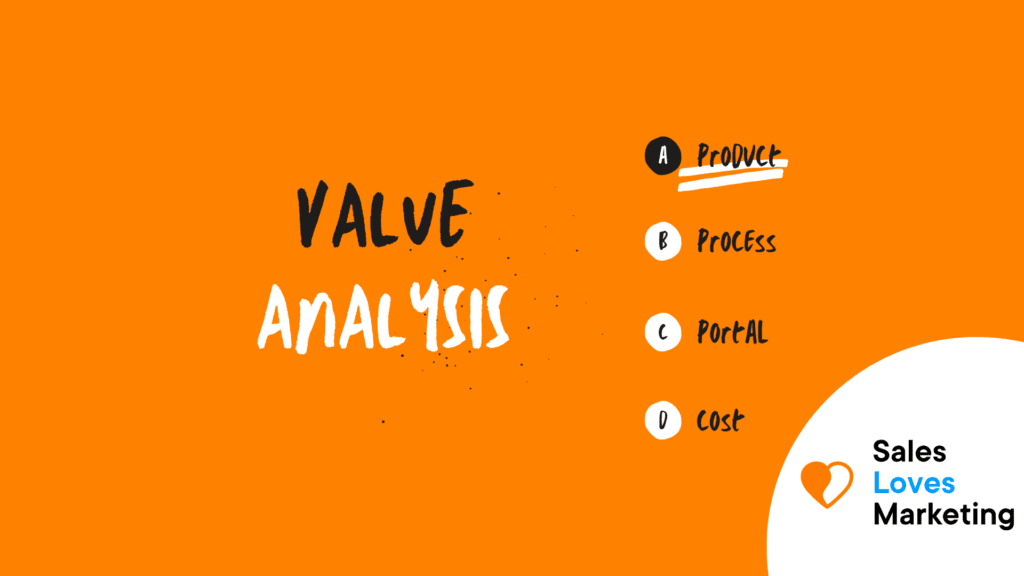What is Value Analysis?
The value analysis is a study that seeks to give greater value to a product, process, or service through the understanding of the components that make it up and their associated costs.
Its subsequent objective is to find improvements to the components either through cost reduction or by improving the functions’ value.
In the field of marketing, value analysis is a technique used by an industrial buyer to determine the most economical combination of raw materials or elements necessary to create a product, without this leading to a decrease in the quality of the finished product.
How does Value Analysis work?
To understand how value analysis works, it is necessary to know some basic concepts:
- Value: the link between a function to satisfy the customer and the cost of that function.
- Function: the result that a product or one of its elements generates, with the purpose of satisfying the client’s needs.
- Value analysis: the procedure used to increase the value of an object, the object to be studied could be an existing product, service, or process or a new one, and it is often carried out by a team that is guided by a work plan.
- Need: it is something that the client needs or wants.
The functions can be separated into categories, starting with a simple function, for which the customer assumes that they are paying, and then additional functions, which support that initial simple function.
The purpose of the functions can be purely aesthetic or of use, and the simple or basic functions can be one or both of these. For example, gloves can have the simple function of giving warmth and an aesthetic function of “making it look elegant.”
The product, process, or service can be separated into elements, which can be related to the functions they support. The value of the product, process, or service can be increased by improving or changing individual elements. This also fits the entire article that has been studied, which can be totally replaced by a more practical or lower-cost solution.
Although this is a tool that may seem simple at first glance, it cannot be easy in the practical field, since it is necessary both a thorough study of the product, process, or service to improve, as well as an innovative point of view to find alternatives.
Steps to perform a Value Analysis
- Information Phase: here, it is about understanding the reason for the project and who are the people involved in the production, and of course, what is going to be produced. Project data, designs, product concepts are collected, and schedules, costs, budgets, associated risks, and project scope are studied.
There are also site visits, meetings with the project team, and documents related to the project, such as drawings and plans, are studied.
- Function analysis phase: here, we try to define the functions that the project fulfills. Functions come in two forms:
- The primary functions are those that represent the main motive of the project, its reason for being.
- Secondary functions that are served by the project but are not essential.
At this stage, the field experts are of great help, but you can also work using an appropriate level of analysis and brainstorming.
- Creative phase: at this stage, ideas for improvement are generated. The team must create parallel ways in which the project can fulfill the functions that have been determined. Each function must be studied individually, and from each one, a list of alternate ways of fulfilling the function is drawn.
- Evaluation stage: here, each project improvement idea is prioritized. Ideas are argued, and potential costs are agreed upon. When you have the risk-reward profile of each idea in detail, you determine which ideas are worth establishing in the project or feature.
- Development phase: In this phase, the value engineering team refines the alternatives to the point of returning them to the initial project team. Any potentially negative factors are determined. Potential costs and cost savings are specified.
- Presentation phase: at this stage, the different options are presented to the stakeholders. Some common results in a value engineering analysis are risk analyses, informational documents, trade-offs, present value analyses, etc.
Value Analysis Benefits
- Reduce costs: A critical advantage of using value analysis is its ability to lower costs, which is a benefit that needs no further explanation. A well-done and used value analysis can discover elements that are not worth the cost they need, which can be replaced by an alternative or outright eliminated. Thus, the process is refined, and the product or service that is analyzed is made at a reduced cost.
- Take advantage of new technology: in many cases, value analysis allows users to change or eliminate obsolete procedures which can be replaced by more modern perspectives. A value analysis, which needs to challenge each stage of a process, can reveal new ways of doing things and technologies that are more efficient, economical, and effective.
- Helps improve the design: Through value analysis, design errors can be discovered that create problems or perform inefficiently. In the case of products, this could mean a large quantity of merchandise with defects, which in turn brings with it complaints and warranty claims from users. It can also cause bad publicity and hurt the brand and the company that makes it.
